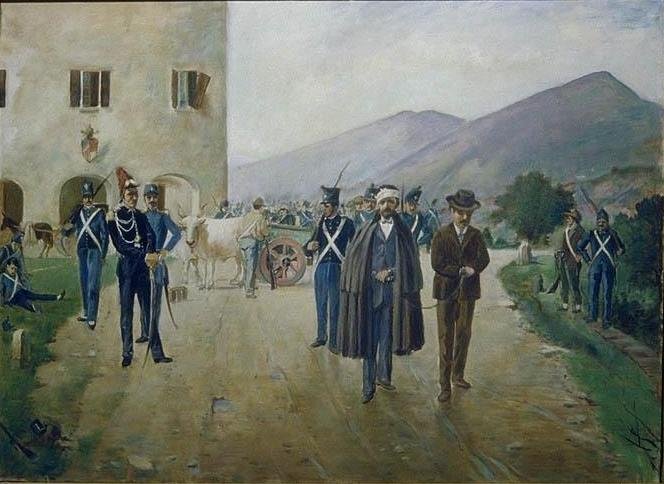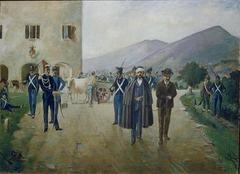
Museo Del Risorgimento e dell’Età Contemporanea Faenza: Comprehensive Guide to Visiting Hours, Tickets, and Historical Highlights
Date: 14/06/2025
Introduction
Situated in the heart of Faenza, Italy, the Museo del Risorgimento e dell’Età Contemporanea offers an enriching exploration of Italy’s path from the Napoleonic era, through the Risorgimento and unification, into the tumultuous 20th century. Housed in the neoclassical Palazzo Laderchi—a landmark of local aristocratic heritage—the museum features over 5,000 artifacts, including paintings, photographs, proclamations, uniforms, and memorabilia. This guide provides all essential information, from visiting hours and ticket details to accessibility and nearby attractions, ensuring a rewarding experience at one of Faenza’s most significant cultural institutions (Musei di Faenza, Faenza Romagna, Comune di Faenza).
Table of Contents
- Introduction
- Historical and Cultural Significance
- Architectural and Artistic Features
- The Museo del Risorgimento e dell’Età Contemporanea
- Visitor Information
- Visitor Experience
- Travel Tips and Nearby Attractions
- FAQs
- Conclusion and Call to Action
- References
Historical and Cultural Significance
Palazzo Laderchi: Origins and Context
Palazzo Laderchi, a symbol of Faenza’s noble past, was commissioned in 1780 by Count Ludovico Laderchi, whose family lineage dates back to the medieval locality of Laderchio. Strategically located at the corner of Corso Garibaldi and Via XX Settembre, the palace’s construction was a statement of status and influence, made possible by acquiring and relocating the Parrocchia di San Biagio (faenza.amacitta.it, it.wikipedia.org).
The Laderchi Family Legacy
The Laderchi family played a central role in Faenza’s civic and cultural life for centuries. Notably, Achille Laderchi (1830–1906) was active in the Risorgimento and served twice as mayor of Faenza, reflecting the family’s enduring public influence. Commemorative stones at the palace’s entrance mark key family milestones, underlining its significance as a local institution (it.wikipedia.org, ruggeri-laderchi.com).
Architectural and Artistic Features
Designed by architect Francesco Tadolini, the palace exemplifies neoclassical harmony and elegance, with its symmetrical façade and refined neo-Renaissance details (italyformovies.com). The interiors are especially notable for the “Grande Galleria,” featuring a ceiling frescoed by Felice Giani in 1794, and decorative plasterwork by Antonio Trentanove. The elliptical astronomical study, completed in 1797, reflects Enlightenment-era interests and the family’s intellectual pursuits.
The Museo del Risorgimento e dell’Età Contemporanea
Permanent Collections
The museum’s holdings chronicle Italy’s transformation from the late 18th century to the present, with more than 5,000 catalogued works—prints, paintings, uniforms, flags, weapons, photographs, and documents. Emphasis is placed on both national events and Faenza’s local contributions (Musei di Faenza, PatER, Romagna Faentina).
Thematic and Chronological Galleries
The museum is organized into six thematic sections:
- Napoleonic Era in Faenza: Documents and artifacts from French occupation and reforms.
- Risorgimento and Unification: Maiolica portraits of national and local patriots, original tricolor flags, weapons, and proclamations.
- Birth of the Italian State: Artifacts reflecting social and economic changes post-unification.
- World Wars and Interwar Period: Soldiers’ memorabilia, resistance materials, and a reconstructed bomb shelter.
- Contemporary Age: Postwar recovery and European integration, presented through photographs and multimedia displays.
- Preservation of Memory: Artistic and documentary testament to Faenza’s role in national history.
Special Collections and Highlights
- Maiolica Portraits: Works by Angelo Marabini depicting figures like Aurelio Saffi and Cavour.
- Sculptures: Terracotta bust of Giuseppe Mazzini by Domenico Baccarini; marble bust of Napoleon attributed to Raimondo Trentanove.
- The Cantoni Collection: Personal effects and correspondence of local patriot Achille Cantoni.
- Resistance Archive: Extensive oral histories and photographs from WWII resistance.
- Sala Saviotti and Galleria di Psiche: Spaces housing significant paintings, memorabilia, and documents (Faenza Romagna).
Visitor Information
Hours, Tickets, and Accessibility
- Opening Hours: Tuesday–Sunday, 9:00 AM–6:00 PM. Closed Mondays and public holidays. Always check the official website for updates.
- Admission: Free entry for all; guided tours available by reservation.
- Accessibility: The museum is fully accessible, with ramps, elevators, and adapted facilities for visitors with mobility or sensory impairments. Audio guides and large-print materials are available.
- Location: Corso Giuseppe Garibaldi, 2, 48018 Faenza RA, Italy; easily reachable on foot, by public transport, or by car (parking nearby).
Guided Tours and Special Events
Guided tours—tailored to schools, families, and adult groups—can be booked in advance. The museum also regularly hosts temporary exhibitions, public lectures, and commemorative events. Check the Musei di Faenza events page or contact the museum for the latest offerings.
Visitor Experience
Exhibition Design and Educational Resources
The museum features a user-friendly layout with thematic galleries, bilingual (Italian-English) interpretive labels, interactive touchscreens, and temporary exhibitions. Educational programs, workshops, and digital resources—including a virtual 3D tour and online catalog—are available for all ages (Musei di Faenza – Catalogo).
Community Engagement and Digital Access
The museum is dedicated to inclusive education, offering didactic pathways for schools and families, as well as virtual resources for remote visitors. Community outreach is supported through public programming and active social media presence (Sistema Musei Ra, MIURF).
Travel Tips and Nearby Attractions
- Best Time to Visit: Weekday mornings tend to be less crowded.
- Nearby Attractions: Piazza del Duomo (Faenza Cathedral), Museo Internazionale delle Ceramiche, Palazzo Milzetti, and the Pinacoteca Comunale. Explore local shops and cafes on Corso Garibaldi.
- Dining: Enjoy traditional Romagna cuisine at restaurants and cafes near the museum.
- Travel: The museum is centrally located and accessible via train, bus, or car.
Frequently Asked Questions (FAQ)
Q: What are the museum’s opening hours?
A: Tuesday–Sunday, 9:00 AM–6:00 PM. Closed on Mondays and public holidays.
Q: Is admission free?
A: Yes, entry is free for all visitors.
Q: Are guided tours available?
A: Yes, book in advance for group or thematic tours.
Q: Is the museum accessible for disabilities?
A: Fully accessible, with ramps, elevators, and adapted resources.
Q: Can I access collections online?
A: Yes, virtual tours and digital catalogs are available on the museum’s website.
Q: Are photography and video allowed?
A: Policies may vary; inquire at the entrance.
Q: What nearby historical sites should I visit?
A: Faenza Cathedral, Palazzo Milzetti, and the International Museum of Ceramics.
Conclusion and Call to Action
The Museo del Risorgimento e dell’Età Contemporanea in Faenza offers an immersive journey into Italy’s national and local history, set within the remarkable Palazzo Laderchi. Its rich collections, engaging exhibitions, and accessible facilities make it a must-visit cultural destination for travelers, students, and history enthusiasts alike.
To maximize your visit:
- Check the official website for current hours and events.
- Book a guided tour for deeper insight.
- Explore nearby sites to enrich your experience of Faenza’s historical and artistic heritage.
- Download the Audiala app for audio guides and curated itineraries.
- Follow museum and city cultural channels for updates.
Embrace Faenza’s vibrant past and make the Museo del Risorgimento e dell’Età Contemporanea a highlight of your Italian journey!
References and Further Reading
- This guide draws on resources from Musei di Faenza, Faenza Romagna, Comune di Faenza, faenza.amacitta.it, Romagna Faentina, associazionelericavour.it, italyformovies.com, ruggeri-laderchi.com, PatER, and Sistema Musei Ra.
